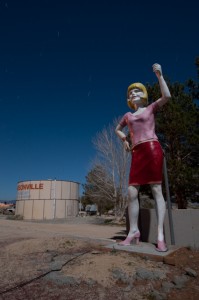 |
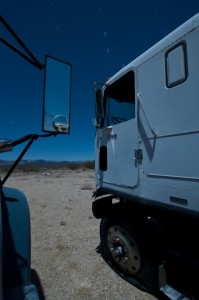 |
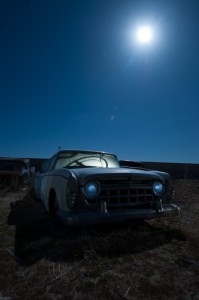 |
 |
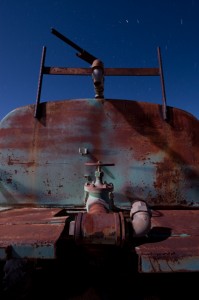 |
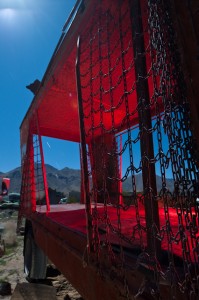 |
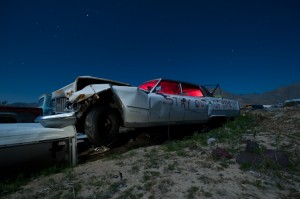 |
||
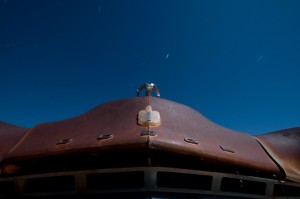 |
||
 |
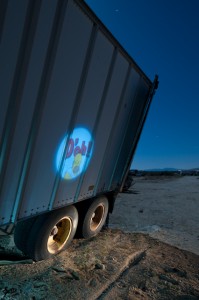 |
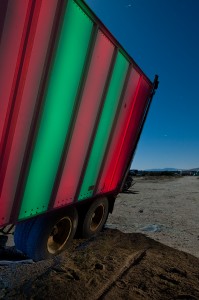 |
Would you consider photographing a junkyard? What if it was during a weekend workshop by the light of the full moon? Does it sound dirty, fun, or both? What if I told you that master lightpainter, Troy Paiva, teamed up with ghost-making Joe Riefer to lead the expedition to the classic car filled Pearsonville Junkyard? Does that peak your interest? Both of these guys are on the forefront of capturing long exposures at night in surreal and abandoned urban areas. They both have huge followings – Troy with his vibrant light paintings of desolate planes, trains, and automobiles has practically all of Flickr following his every post. His recent book Night Vision: The Art of Urban Exploration is an inspirational look at forgotten America. Joe Riefer’s blog on Night Photography is probably the best out there and if you don’t have it in your feedreader, mark it now. Joe is the Ying to Troy’s Yang, his subtle CTO light painting finesses (opens) the shadows and his digital post processing information is one of the best in that deals with the night light.
So when they invited me to join them on a 7 hour drive to the Mojave desert to take their Pearsonville Night Photography/Light Painting Workshop, I cleared my schedule. This was their second workshop they’ve offered at this truly unique place, the last one took place during October 08’s full moon. The class is limited to 11 students and a bargain at $500 for two nights! We had total access into the Pearsonville Junkyard – a virtual wasteland of decaying classic cars and trucks mainly from 50’s -70’s’.
Pearsonville, population 24, has definitely seen better days. Troy and Joe have been shooting this place for years, and have built an excellent relationship with the owners, which is literally the “key” element to shooting a semi-abandoned place like this.
The lucky 11 met with Joe and Troy on Saturday at 1pm. They showed us their Pearsonville pictures and went over several night lighting techniques before we made the 20 minute commute to stock up on the food and enter the graveyard of cars.
The 40′ tall Uni-Royal lady surrealy beckoned us to the gate, we had a little over an hour before sunset to scope out the 1/2 mile by 1/2 mile junkyard looking for possible night shot set ups. Joe and Troy warned us not to get lost in just a few cars or a small area as there was an amazing shot every step you took. And with exposures averaging 6-8 minutes, you really didn’t want to spend more than two set ups for each car. I walked half the back lot of the car graveyard during the sinking sunlight, getting quick digital grab shots to see what angles worked. I’m not really a car guy but 3 steps in and I was captivated by these dying engineering beauties. I worked quickly in the sinking sunlight getting grab shots of these hulking metal beasts I’d only heard rumors of, familiar wide 70’s chryslers to the famous rare Edsels.
My gear list consisted of 3 camera rigs:
- Fuji S5 with a Nikon 17-55 2.8 to shoot the daylight test shots
- Nikon D3 with a 14-24 lens ~ Thanks to Mark Kettenhofen at Nikon for letting me borrow this perfect rig. A single battery lasted me the entire 7 hours of shooting each night!
- Mamiya 7 and the 43mm wide angle lens of course I’m gonna shoot film, especially when you have time for the 45+ minute exposures!
- Two Gitzo tripods – the 3541 and the traveler locked into my new holster.
- Hot Shoe Bubble level – really invaluable for making sure your horizon was straight.
- Vivitar 285 flash with the new and highly recommended color gel set by honl.
- 3 flashlights – the powerful Surefire defender with diffuser, a tricolor low watt LED light
Gerber 22-80016 Recon Light, White / Red / Blue / Green LED - Black Body, and finally one of the students, Dave Abrams, kindly brought a bunch low level flashlights for the class he got off ebay for $2 each! I covered mine with a cto gel and this became my main light close up work. Thanks Dave! - I would also recommend the Honl 8″ snoot to control the light for more specific light painting.
Wide or Super-wide are really the way to go. The two modes of thought when capturing the cars were what accentuating angle (usually wide) do you interpret the vehicle with as well as sharp detail shots. Of course on the first night I got lost in a small area of old and modern trucks in the back, but finally met up with Joe at the racetrack. Yes, they used to race cars here as well back in the day! In the middle of the track was a firetruck from the 20’s that I spent a lot time trying to figure out. In between exposures Joe asked me to become one of his classic ghosts. The image, ironically called, Towing from Beyond came out great and you can see it here.
The second day we brought our top 5 shots from the night, got feedback from Joe and Troy and then went over several digital post processing tips on how to get the most out of your image. Joe has been posting several of these techniques on his website, check out A Warm Car on a Cool Night.
After mainly working alone the first night, I made it a point to spend a couple hours with Troy and Joe each night and improve my light painting techniques. You can see Troy’s collaboration with me on the red chained trailer, candycane 18 wheeler, and of course the famous D’oh! shot! Joe taught me the cool and ever useful steering wheel shadow technique and how to get the most of my gelled color temperature controlled flashlights by gently remove shadows and adding highlights to certian areas of the vehicles.
For and extra $100 Joe and Troy offered a bonus 3rd day of night shooting that 3/4 of the class participated in. You could see flashes popping and colors flashing in the distance as we worked well into the final night of Pearsonville. As we drove away late that last night, I knew I had only scratched at the surface of the secrets of Pearsonville, and that I would hopefully, be making this trip again before it disappears.
Check out a few more of my shots as well as the rest of the amazing work from the rest of the students on the Pearsonville flickr page. Troy is still creating Pearsonville gems on his 5+ visit, check out his new shots here. And finally Joe’s blogs on shooting and post-processing techniques can be found here and here and here! Oh just check out his whole blog!
Rumor has it that Joe and Troy will be offering this again in October, so stay tuned if you are interested in capturing the rides of your night-time!
Gabe,
These shots are awesome! I especially like “Stay Outa Here”, and “Rambler”. I’ll be there in October!
Angus ~ The candy truck was made with a red gelled and then green gelled flashlight shot through a long paper towel like tube to control the spill of the light better. It took several takes, and it was very important to keep the light moving so no hot spots were created by holding the light too long in one area. I’m very thankful for Troy for tutoring me through this one!
Joe ~ sign me up!
Brandon ~ I hope to post the film shots soon…still developing!
those are awesome indeed! such great colors – and love the FILM plug! yes indeed!
Thanks for all the kind words. Tough not to have a great time at this spot! We’re planning an October workshop, and will be making an announcement in early June regarding the schedule and curriculum. Anyone who’s interested can contact me to get on the pre-notification list — both of the previous workshops were sold out!
Whoa. How’d you get that “Candy Truck”? Awesome-ness.
PEACE,
A